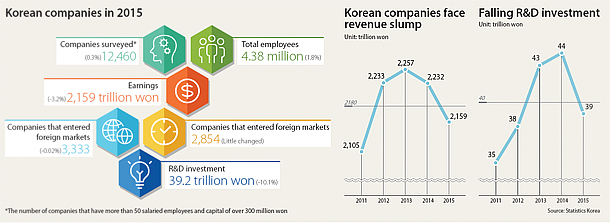Korea Inc. revenue falls to 2011 level

According to Statistics Korea on Tuesday, the number of companies with more than 50 salaried employees and capital of over 300 million won ($255,000) rose 0.3 percent from 2014 to 12,460 in 2015. Even though the number of companies rose compared to the past, their combined revenue dropped 3.2 percent, or 72 trillion won, to 2,159 trillion won.
This is the second year that Korean companies’ combined earnings has fallen year on year. Since the data was compiled in its current form in 2006, revenue had increased every year and retreated for the first time in 2014.
Combined earnings for 2015 fell below the 2,200 trillion won level for the first time in four years, and the figure is close to where it was in 2011, when it recorded 2,105 trillion won.
“Manufacturing, which is one of the biggest sectors when it comes to overall sales, saw their earnings drop 74 trillion won, or 5.3 percent, compared to the previous year to record 1,385 trillion won in 2015,” said Kang Yoo-kyung, a director at Statistics Korea. “Sales of petrochemical, shipping and shipbuilding companies dropped significantly from the past, and it appears that restructuring, which began to affect the manufacturing sector in late 2014, might have dragged down sales.”
Things are likely to get worse in the future, as the influence-peddling scandal surrounding presidential confidante Choi Soon-sil is expected to affect domestic consumption while U.S. President-elect Donald J. Trump’s protectionist trade policies will likely exacerbate conditions already made worse by restructuring in Korea’s shipping and shipbuilding industries.
“The government has been unable to proceed with much of its policies due to the Choi Soon-sil scandal, but they are, for some reason, pushing forward deployment of the U.S.-led missile defense system as planned,” said Lee Ki-hoon, an analyst at Hana Financial Investment. “The Chinese government has announced it will ban Korean culture, including dramas and movies, from appearing on their state-run channels, and that will have a negative impact on Korean companies for quite some time.”
Korean conglomerates are also planning to minimize their annual year-end reshuffle as top executives have been summoned by the prosecution for investigation into Choi’s alleged abuse of power and conglomerates’ involvement. Many companies fear the fallout from the scandal may lead to a management vacuum.
To make things worse, the government data also showed that Korean companies are cutting down on expenditures as well. Their net profit rose 16 percent year on year to 109 trillion won, and the net profit they received from earning 1,000 won rose 8.4 won year on year to 50.4 won. This means they were able to make 50.4 won in profit after selling 1,000 won in product.
Companies have cut down on R&D investment as well as the number of salaried employees. R&D investment fell 10.1 percent to 39.2 trillion won, and the number of companies that actually ran R&D projects fell 5.6 percent to 5,874.
“R&D investment in electronics, transportation and pharmaceuticals fell significantly from the past,” said Kang at the statistics agency. “Government data shows there were a large number of workers that were laid off by private research institutions as well.”
R&D investment in the manufacturing sector accounted for 88.5 percent of the total in 2014.
The overall number of employees at companies surveyed was 4.38 million, up 1.8 percent from the previous year. Even though the overall number rose, the number of salaried full-time workers dropped 1 percentage point to account for 87.7 percent of the total. Contract and part-time workers, on the other hand, rose from 11.3 percent in 2014 to 12.3 percent last year, suggesting companies are spending less on their workforce.
The number of manufacturing companies surveyed by the government dropped 2.2 percent to 5,817. “The number dropped from the past as there were some companies that cut their workforce to below the 50-employee level and some that merged with other companies,” Kang said.
During the same period, the number of lodging facilities and restaurants rose 7.9 percent to 342, and the number of real estate and rental service providers rose 13.1 percent to 310.
A total of 3,333 companies surveyed ran businesses overseas, and they accounted for 26.7 percent of the total, a 0.6 percentage point drop from the previous year.
BY KIM YOUNG-NAM [kim.youngnam@joongang.co.kr]










with the Korea JoongAng Daily
To write comments, please log in to one of the accounts.
Standards Board Policy (0/250자)